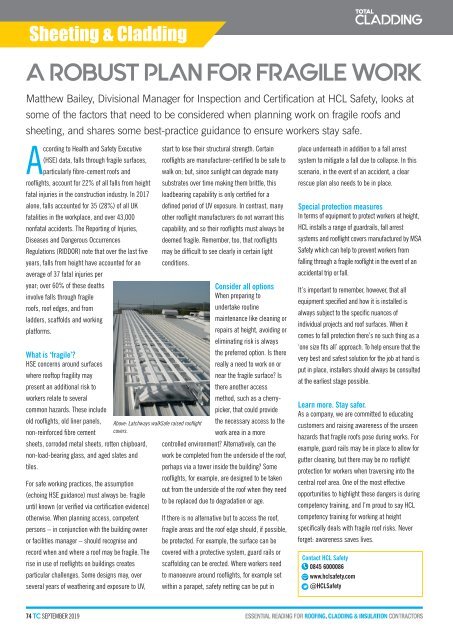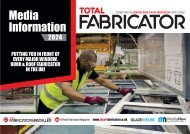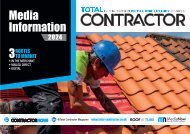September 2019
You also want an ePaper? Increase the reach of your titles
YUMPU automatically turns print PDFs into web optimized ePapers that Google loves.
Sheeting & Cladding<br />
A ROBUST PLAN FOR FRAGILE WORK<br />
Matthew Bailey, Divisional Manager for Inspection and Certification at HCL Safety, looks at<br />
some of the factors that need to be considered when planning work on fragile roofs and<br />
sheeting, and shares some best-practice guidance to ensure workers stay safe.<br />
According to Health and Safety Executive<br />
(HSE) data, falls through fragile surfaces,<br />
particularly fibre-cement roofs and<br />
rooflights, account for 22% of all falls from height<br />
fatal injuries in the construction industry. In 2017<br />
alone, falls accounted for 35 (28%) of all UK<br />
fatalities in the workplace, and over 43,000<br />
nonfatal accidents. The Reporting of Injuries,<br />
Diseases and Dangerous Occurrences<br />
Regulations (RIDDOR) note that over the last five<br />
years, falls from height have accounted for an<br />
average of 37 fatal injuries per<br />
year; over 60% of these deaths<br />
involve falls through fragile<br />
roofs, roof edges, and from<br />
ladders, scaffolds and working<br />
platforms.<br />
What is ‘fragile’?<br />
HSE concerns around surfaces<br />
where rooftop fragility may<br />
present an additional risk to<br />
workers relate to several<br />
common hazards. These include<br />
old rooflights, old liner panels,<br />
non-reinforced fibre cement<br />
sheets, corroded metal sheets, rotten chipboard,<br />
non-load-bearing glass, and aged slates and<br />
tiles.<br />
For safe working practices, the assumption<br />
(echoing HSE guidance) must always be: fragile<br />
until known (or verified via certification evidence)<br />
otherwise. When planning access, competent<br />
persons – in conjunction with the building owner<br />
or facilities manager – should recognise and<br />
record when and where a roof may be fragile. The<br />
rise in use of rooflights on buildings creates<br />
particular challenges. Some designs may, over<br />
several years of weathering and exposure to UV,<br />
Above: Latchways walkSafe raised rooflight<br />
covers.<br />
start to lose their structural strength. Certain<br />
rooflights are manufacturer-certified to be safe to<br />
walk on; but, since sunlight can degrade many<br />
substrates over time making them brittle, this<br />
loadbearing capability is only certified for a<br />
defined period of UV exposure. In contrast, many<br />
other rooflight manufacturers do not warrant this<br />
capability, and so their rooflights must always be<br />
deemed fragile. Remember, too, that rooflights<br />
may be difficult to see clearly in certain light<br />
conditions.<br />
Consider all options<br />
When preparing to<br />
undertake routine<br />
maintenance like cleaning or<br />
repairs at height, avoiding or<br />
eliminating risk is always<br />
the preferred option. Is there<br />
really a need to work on or<br />
near the fragile surface? Is<br />
there another access<br />
method, such as a cherrypicker,<br />
that could provide<br />
the necessary access to the<br />
work area in a more<br />
controlled environment? Alternatively, can the<br />
work be completed from the underside of the roof,<br />
perhaps via a tower inside the building? Some<br />
rooflights, for example, are designed to be taken<br />
out from the underside of the roof when they need<br />
to be replaced due to degradation or age.<br />
If there is no alternative but to access the roof,<br />
fragile areas and the roof edge should, if possible,<br />
be protected. For example, the surface can be<br />
covered with a protective system, guard rails or<br />
scaffolding can be erected. Where workers need<br />
to manoeuvre around rooflights, for example set<br />
within a parapet, safety netting can be put in<br />
place underneath in addition to a fall arrest<br />
system to mitigate a fall due to collapse. In this<br />
scenario, in the event of an accident, a clear<br />
rescue plan also needs to be in place.<br />
Special protection measures<br />
In terms of equipment to protect workers at height,<br />
HCL installs a range of guardrails, fall arrest<br />
systems and rooflight covers manufactured by MSA<br />
Safety which can help to prevent workers from<br />
falling through a fragile rooflight in the event of an<br />
accidental trip or fall.<br />
It’s important to remember, however, that all<br />
equipment specified and how it is installed is<br />
always subject to the specific nuances of<br />
individual projects and roof surfaces. When it<br />
comes to fall protection there’s no such thing as a<br />
‘one size fits all’ approach. To help ensure that the<br />
very best and safest solution for the job at hand is<br />
put in place, installers should always be consulted<br />
at the earliest stage possible.<br />
Learn more. Stay safer.<br />
As a company, we are committed to educating<br />
customers and raising awareness of the unseen<br />
hazards that fragile roofs pose during works. For<br />
example, guard rails may be in place to allow for<br />
gutter cleaning, but there may be no rooflight<br />
protection for workers when traversing into the<br />
central roof area. One of the most effective<br />
opportunities to highlight these dangers is during<br />
competency training, and I’m proud to say HCL<br />
competency training for working at height<br />
specifically deals with fragile roof risks. Never<br />
forget: awareness saves lives.<br />
Contact HCL Safety<br />
0845 6000086<br />
www.hclsafety.com<br />
@HCLSafety<br />
74 TC SEPTEMBER <strong>2019</strong>

















